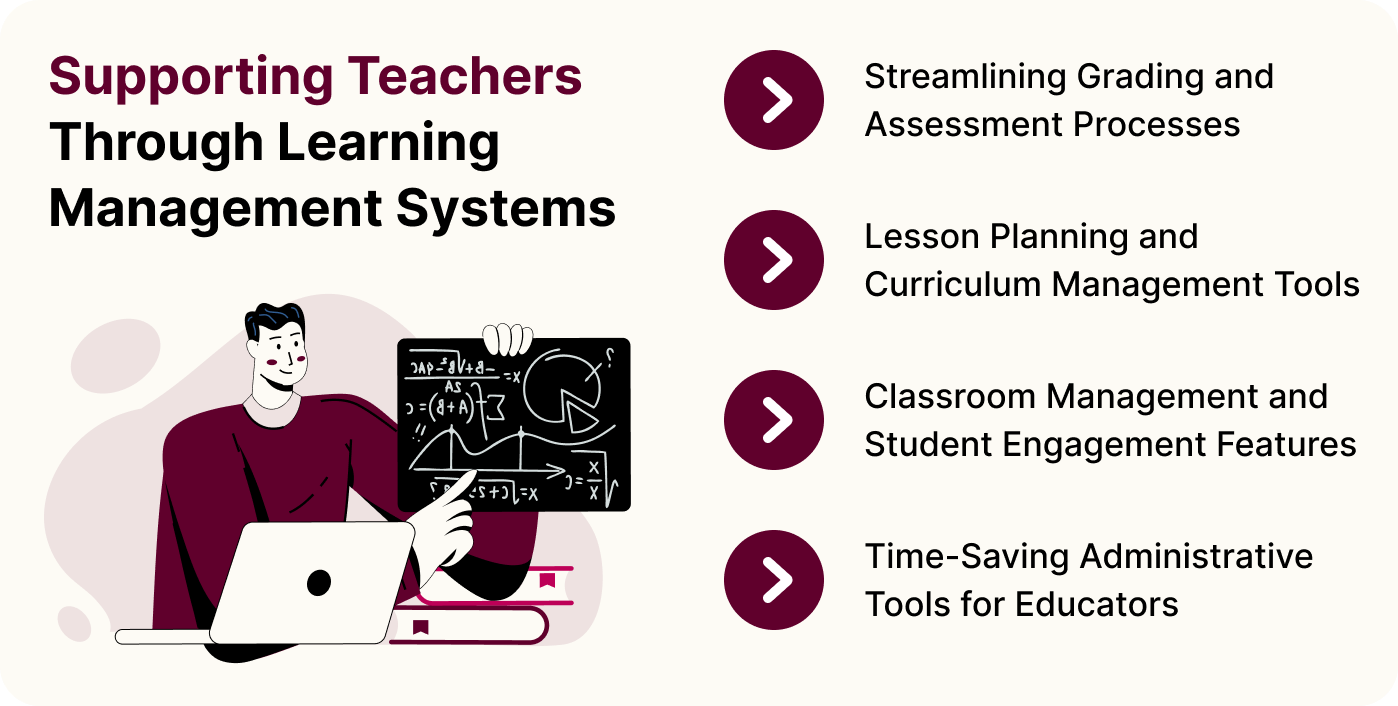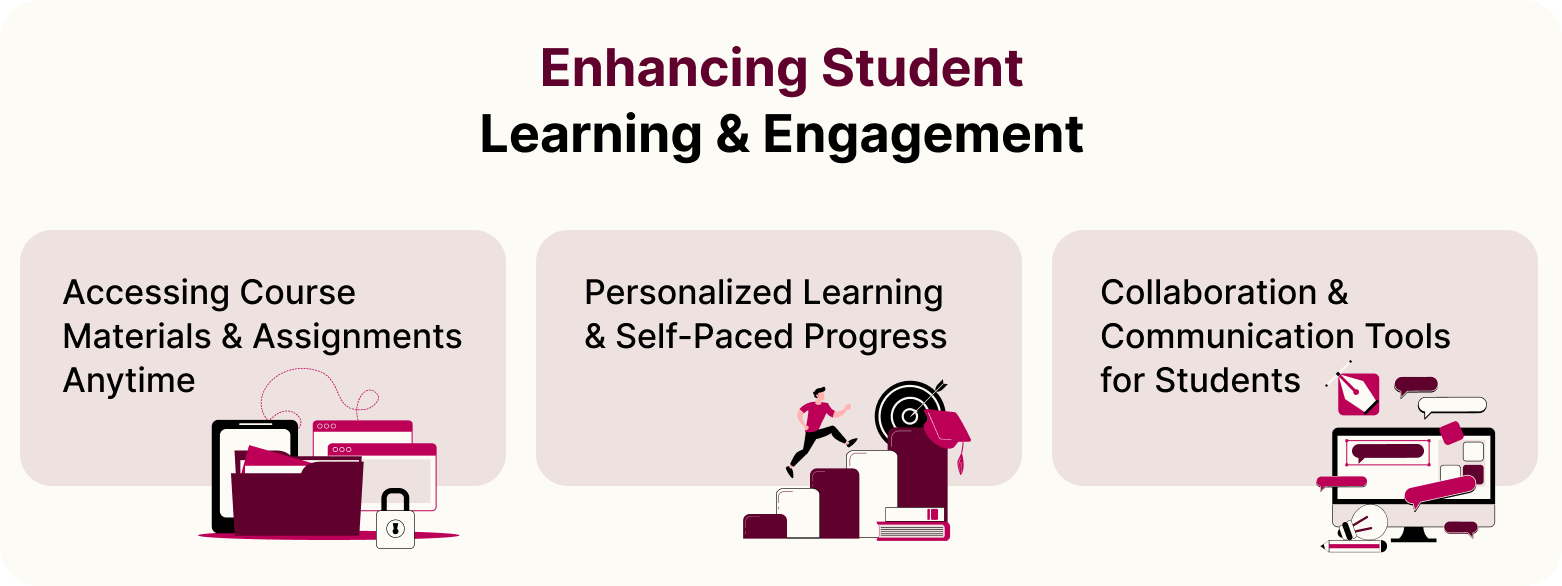Learning Management Systems in Education: Supporting Teachers, Students, and Parents

Education has entered a new era where digital learning has evolved from a bonus into a necessity. Schools, colleges, and universities around the world are currently reshaping their teaching models through technology. As a result, learning management systems (LMS) have become the backbone of modern education – connecting teachers, students, and parents in a unified digital environment. This expansion reflects fundamental shifts in how schools and universities approach teaching, learning, and stakeholder engagement, according to UNESCO's research on digital education.
If this change is relevant to your educational targets, profession, or business needs, read on to find out everything about LMSs for learning. This article offers an informative breakdown on what LMSs are, how educational LMSs differ from general-purpose software, and how LMSs support all educational stakeholders. It also provides a step-by-step guide for a smooth LMS implementation in your organization.
What Are Learning Management Systems in Education
Learning management systems in education are comprehensive digital platforms that connect teachers, students, and parents through course management, assignment tracking, grading tools, and communication features.
Educational institutions from elementary schools to universities deploy these platforms to streamline instruction, enhance student engagement, provide real-time progress visibility to parents, and centralize all learning activities in one accessible location.
Unlike consumer apps or basic websites, educational LMSs are explained as integrated ecosystems where curriculum delivery, assessment, grading, attendance, and parent communication converge into unified digital environments.
Core Components of Educational LMS Platforms
An educational LMS includes tools designed specifically for schools, with its main functions geared to supporting teaching, assessment, and communication.
LMS's purpose in education centers on six foundational capabilities that distinguish platforms built for academic settings:
- Content management allows teachers to organize curriculum materials, upload resources, and structure courses with modules and units.
- Assignment submission systems enable students to turn in work digitally while teachers track completion and provide feedback.
- Gradebook functionality calculates scores, weights categories, and generates report cards automatically.
- Communication tools facilitate announcements, messaging between teachers and students, parent portal access, and discussion forums.
- Assessment features support quiz creation, test administration, and various question formats from multiple choice to essays.
- Analytics dashboards provide visibility into student progress, engagement patterns, and learning outcomes for educators and administrators.
How Educational LMS Differs from Enterprise Learning Systems
Next, it’s worth comparing educational LMS platforms with business or enterprise systems. Although they share the same name, their goals, design, and purpose are completely different.Understanding these distinctions helps schools choose systems built for academic use instead of repurposing business-oriented tools. The main differences lie in user experience, compliance rules, stakeholder roles, learner support, and scheduling structure.
Here is a summary of the main distinctions worth considering:
Why Schools and Universities Need Learning Management Systems
Let's look at why schools actually need LMS platforms. The reasons are simple and powerful. Three compelling factors drive digital transformation in schools through LMS adoption.
- Centralization eliminates scattered resources across multiple platforms. Teacher workload reduces when an LMS consolidates lesson materials, assignments, grades, and communication in one location. Teachers report saving 3-5 hours weekly on administrative tasks after implementing comprehensive LMS platforms.
- Transparency empowers parents and students with real-time access to grades, assignments, and progress data. This visibility eliminates surprises at the final testing stage and enables early intervention when students struggle.
- Scalability allows institutions to serve hundreds or thousands of students consistently, ensuring equitable access to quality educational experiences regardless of teacher, classroom, or campus location.
Supporting Teachers Through Learning Management Systems
The educator should be the main beneficiary of LMS integration. LMS features for teachers transform daily workflows by automating routine tasks, streamlining assessment processes, and providing data-driven insights that inform instructional decisions. Teacher tools in learning management systems directly address the three most time-consuming aspects of teaching beyond direct instruction: grading, planning, and communication. Let’s see how improvements work in more detail.

Streamlining Grading and Assessment Processes
Digital gradebook for educators calculates weighted grades automatically based on teacher-defined categories like homework, tests, projects, and participation. Grading tools for teachers eliminate manual calculation errors while enabling complex grading schemes, including standards-based approaches, competency tracking, and mastery learning frameworks. Assessment gets more simplified and automated with the following changes:
- Automated assessment features grade objective questions instantly, providing immediate feedback to students while freeing teachers from scoring hundreds of multiple-choice or true/false questions.
- Rubric builders allow teachers to create detailed scoring guides once, then apply them consistently across assignments with simple clicks rather than writing lengthy feedback repeatedly.
What’s more, online submission eliminates lost papers, late work disputes, and the physical burden of carrying stacks of assignments home, transforming educational documentation management.
Lesson Planning and Curriculum Management Tools
Lesson planning with LMS centralizes curriculum resources, pacing guides, and instructional materials in organized digital libraries. Teachers build course structures with units and modules that sequence learning logically, embedding multimedia resources directly into lessons. They can also reuse successful materials across multiple classes or years without relying on paper-based copies or fragmented, complex digital storage.
LMSs also contribute to the creation of a shared, helpful knowledge database. Teachers collaborate by sharing resources with colleagues, accessing district-approved materials, and building on proven lesson designs rather than creating everything from scratch. Version control ensures updates propagate to all sections when teachers improve materials based on student performance data.
What’s more, LMSs can improve educational organizations’ compliance. Curriculum mapping features align lessons to educational standards automatically, simplifying compliance with state requirements and accreditation reviews.
Classroom Management and Student Engagement Features
Classroom management through LMS extends beyond physical space into digital learning environments. Attendance tracking integrates with gradebooks, automatically flagging students with excessive absences for intervention. Behavior monitoring tools document incidents, track improvement plans, and communicate concerns to parents with timestamp records.
Student participation features include discussion boards requiring minimum contributions, peer review assignments building critical thinking skills, and group project spaces with individual accountability tracking. Real-time analytics show which students accessed materials, how much time they spent on activities, and where they struggled, enabling teachers to provide targeted support.
Time-Saving Administrative Tools for Educators
Teacher time-saving LMS features include bulk operations for enrolling students, copying assignments across classes, and sending announcements to multiple sections simultaneously. Scheduling tools automate deadline reminders, send notifications about upcoming assessments, and trigger grade reports at designated intervals.
Key time-saving features include:
- Assignment templates and question banks. Teachers create standardized formats for common assignment types and build repositories of vetted assessment questions, reducing prep time by 60% for recurring activities.
- Bulk grade entry and import capabilities. Uploading scores from external tools or entering multiple grades simultaneously eliminates tedious individual entry, cutting grading documentation time in half.
- Automated late work policies. Platform-enforced deadline consequences apply consistently without teacher intervention, reducing disputes while ensuring accountability.
- Scheduled content release. Teachers prepare materials in advance and set automatic publication dates, maintaining consistent pacing without daily manual updates.
This way, LMS-enabled automated workflows handle routine tasks that typically consume lots of educators’ time. Teachers managing 150+ students report reclaiming 5-8 hours weekly through these efficiency improvements.
Enhancing Student Learning and Engagement
An effective LMS enhances the learning experience for both teachers and students. It enables self-directed progress, structured organization, and meaningful collaboration within the educational process.
However, it’s vital to keep in mind that the quality of the student experience within an LMS largely determines both adoption success and learning outcomes. An effective platform promotes structured organization, supports individualized learning paths, and provides flexible access that adapts to different schedules and study preferences.

Accessing Course Materials and Assignments Anytime
A vital feature of efficient educational LMSs is custom-tailored access management for better student productivity. For instance, student portal features provide 24/7 access to syllabi, lecture notes, readings, videos, and supplementary resources from any internet-connected device. This way, students absent due to illness, family emergencies, or extracurricular activities can access missed content immediately rather than falling behind or relying on peer notes.
Assignment submission through LMS also allows students to upload work before deadlines from home, eliminating forgotten papers and printer malfunctions as excuses. Digital submission timestamps provide definitive proof of on-time completion, resolving disputes objectively.
With mobile-first design taking the lead today, mobile learning capabilities come in handy for learners. They enable students to check grades, read announcements, and participate in discussions from smartphones during commutes, study halls, or between activities.
Personalized Learning and Self-Paced Progress
Personalization is the main strategic benefit of any digital learning platform. Personalized learning in LMS accommodates different mastery speeds through self-paced modules where students progress after demonstrating competency rather than following rigid schedules. These features allow advanced learners to accelerate through material they grasp quickly, while students needing additional time receive it without public comparison to peers.
Adaptive learning paths present content at appropriate difficulty levels based on assessment results, providing scaffolding for struggling students and enrichment for those ready for challenges. Immediate feedback on quizzes helps students identify misconceptions while material remains fresh, enabling self-correction before summative assessments. Progress visualization shows students exactly where they stand, motivating completion and highlighting areas requiring additional attention.
Collaboration and Communication Tools for Students
Another vital benefit of educational LMSs is the creation of a shared learning space conducive to collaboration. Student collaboration features facilitate group projects through shared workspaces, document co-editing, and task assignment tracking that identifies individual contributions. Discussion forums enable thoughtful exchanges where introverted students participate comfortably without competing for airtime in verbal discussions.
Other useful communication tools in LMSs are as follows:
- Peer learning tools like study groups, resource sharing, and question-and-answer forums create communities where students help each other.
- Direct messaging with teachers provides private channels for asking questions without classroom embarrassment.
- File sharing eliminates the logistical complexity of coordinating group work across schedules and locations.
Empowering Parents with Visibility and Communication
With parents also representing a vital stakeholder group in the educational process, LMSs are designed to address parental needs as well. For instance, a parent portal in LMS bridges the information gap between school and home, transforming parental involvement from reactive to proactive. Parent access to student grades also provides transparency that strengthens the home-school partnership essential for student success. Let’s take a closer look at parental support tools in modern LMSs.
Monitoring Student Progress and Academic Performance
Monitoring student progress for parents includes visibility into assignment completion rates, test scores, participation metrics, and attendance records. Parents’ access to student assignments allows families to understand expectations, monitor learning goals, and provide targeted academic support at home. They can see what tasks are assigned, when they’re due, and how each grade contributes to final results. Besides, automated alerts for missed submissions notify parents in real time, enabling early intervention before performance issues become consistent.
Parent transparency in learning platforms allows real-time grade viewing as soon as teachers post scores, eliminating the weeks-long delay between assignment completion and report cards. It helps parents understand academic standing continuously rather than discovering problems only at report card time. This ongoing awareness facilitates conversations about study habits, time management, and help-seeking before grades become irreparable.
Parent-Teacher Communication and Collaboration
Parent-teacher communication tools include secure messaging that maintains documentation of all exchanges, protecting both parties while ensuring clarity. Teachers send progress updates, behavioral observations, and celebration messages recognizing student achievements. Two-way communication allows parents to ask questions, share concerns about learning struggles, and provide context about home situations affecting school performance.
This way, school-to-home messaging delivers important announcements about upcoming tests, field trips, school closures, and curriculum changes directly to parent accounts. LMSs also streamline parent-teacher live communication; conference scheduling features let parents book meetings online during available slots, eliminating phone tag and scheduling conflicts.
Top-rated LMSs also include parent involvement strategies that help families reinforce classroom learning effectively. Parents review upcoming assignments and tests, helping students plan study schedules and manage workload across multiple courses. Such an increased understanding of specific learning objectives allows parents to find supplementary resources, help their children answer homework questions accurately, and recognize when professional tutoring becomes necessary.
Parents can also access advanced student metrics for their children, tracking completion patterns to identify procrastination tendencies, discuss priorities when students feel overwhelmed, and celebrate consistent effort. Parental access to teacher feedback on returned work helps parents understand instructor expectations and areas where students need improvement.
Implementation and Integration of LMS in Education
Effective and smooth LMS implementation requires careful planning and execution. To be more specific, implementing LMS in schools succeeds or fails based on change management strategy, stakeholder training, and technical integration with existing systems. Besides, it’s vital to keep in mind that educational technology implementation requires 6-12 months from selection to full adoption when executed systematically. Here are a couple of tips to make this process smooth and successful:
- LMS integration with SIS (Student Information System) automates roster synchronization, eliminating manual student enrollment and reducing errors from outdated class lists.
- Single sign-on for schools allows students, teachers, and parents to access the LMS with the same credentials used for email and other school systems, reducing password fatigue and support requests.
- Third-party app integration connects specialized tools for mathematics practice, reading assessment, science simulations, and other discipline-specific applications within the LMS interface.
- Data synchronization ensures grades from external tools flow automatically into LMS gradebooks without redundant entry.
Conclusion
Learning management systems in education have evolved from optional technology enhancements into essential infrastructure supporting teaching, learning, and family engagement across K-12 and higher education. Their successful implementation balances robust functionality for teachers with intuitive experiences for students and transparent access for parents. As a result, LMSs enable the creation of digital ecosystems where all stakeholders contribute to academic success.
Frequently Asked Questions






